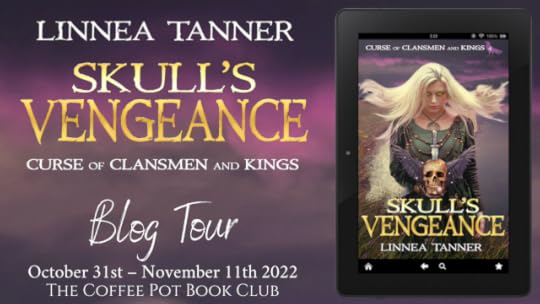Virginia Crow's Blog: Crowvus Book Blog, page 26
November 17, 2022
#HistFicThursdays - Taking Liberties With Histories
This week is Book Week Scotland, and this month is NaNoWriMo. This makes it a very busy time of year! For me as a writer, these two things have something in common: taking liberties with histories!
One of my favourite books by a Scottish author is Kidnapped. If you didn't love roguish characters before reading this (I always have done!) this book will change your mind, and you'll really be rooting for Alan Breck Stewart by the end. It's a book for all ages, and can be read on several levels.
But, although I loved this book, it taught me one very important thing about historical fiction: it doesn't have to be accurate. I'm not sure how I feel about the fact Robert Louis Stevenson knew the history, but still decided to change it - blatantly change it, too, since the dedication makes reference to it in the first paragraph!
I still love the book, though. It is a brilliant adventure through the countryside I know and love.
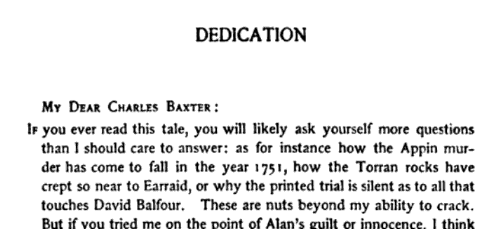
This NaNoWriMo, I'm attempting to write an adventure book - historical, of course. I am trying to write something in every genre I can, and this will tick adventure off the list. And I'm taking a few liberties along the way, although not quite so obviously as RLS! History evolves, and fiction is not the only thing which encourages this. There is a slant to each book you read - there has to be, or no one would have bothered writing it.
So, for the sake of my project, a dual-timeline novel called My Cloak Shall Be My Shroud, I'm attempting an approach with a slightly more relaxed attitude to historical accuracy. My hope was that it would be easier to do this and revisit the facts at the end in the editing stage. In practice, I still have eighteen internet windows of research open, mostly concerning the Roman legions in Britain, but ranging to caudles and disembowelled Jacobites.
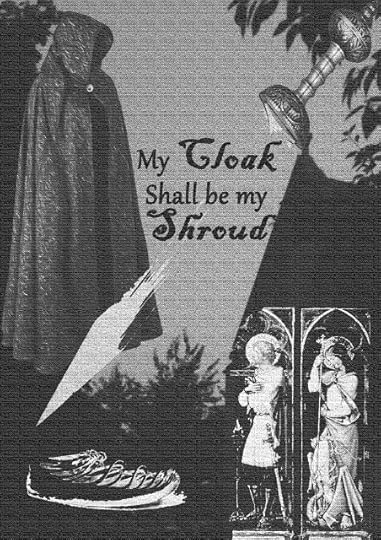
But do you know what I've found? There is a certain amount of freedom to just writing and writing without having to worry about facts, and I also found I know more than I thought! Incorporating potential supernatural threads allows for a certain lenience, too. Early church history and the mysticism of conversions of the first British martyrs is heavily interwoven in the earlier timeline, and ghosts and shadowy forms haunt the later one. Throwing in these beliefs and superstitions allows a certain amount of artistic interpretation for events. And given the vague nature of timings and dates in that earlier period I, like RLS, have tweaked them to line up with what works for my story.
I'm not sure if this is an approach I'll keep for other projects but I have certainly made a discovery as I've plunged down the NaNoWriMo rabbit hole. Historical fiction does not need to be written as prescriptively as I always have done. I don't think I will ever be able to write a story I know to be inaccurate, but there are plenty of gaps in historical knowledge that we, as writers, can exploit.
In short: historical fiction does not need to be factual so much as true.
November 9, 2022
#HistFicThursdays - Squire's Hazard (The Fifth Meonbridge Chronicle) - Carolyn Hughes - Guest Post
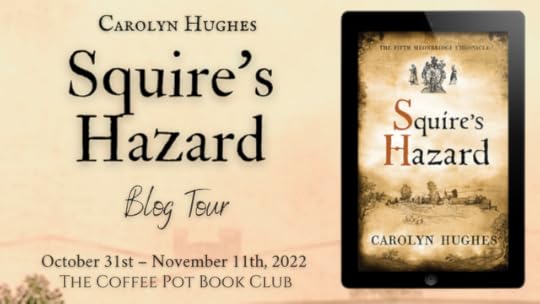
It's #HistFicThursdays, and I'm so excited to be sharing a guest post from Carolyn Hughes, as part of her Coffee Pot Book Club tour. Find out all about family life in the fourteenth century, as it features and impacts on her book, Squire's Hazard. But first, let's meet the book...
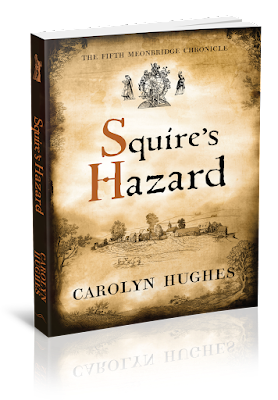
Blurb
How do you overcome the loathing, lust and bitterness threatening you and your family’s honour?
It’s 1363, and in Steyning Castle, Sussex, Dickon de Bohun is enjoying life as a squire in the household of Earl Raoul de Fougère. Or he would be, if it weren’t for Edwin de Courtenay, who’s making his life a misery with his bullying, threatening to expose the truth about Dickon’s birth.
At home in Meonbridge for Christmas, Dickon notices how grown-up his childhood playmate, Libby Fletcher, has become since he last saw her and feels the stirrings of desire. Libby, seeing how different he is too, falls instantly in love. But as a servant to Dickon’s grandmother, Lady Margaret de Bohun, she could never be his wife.
Margery Tyler, Libby’s aunt, meeting her niece by chance, learns of her passion for young Dickon. Their conversation rekindles Margery’s long-held rancour against the de Bohuns, whom she blames for all the ills that befell her family, including her own servitude. For years she’s hidden her hunger for retribution, but she can no longer keep her hostility in check.
As the future Lord of Meonbridge, Dickon knows he must rise above de Courtenay’s loathing and intimidation, and get the better of him. And, surely, he must master his lust for Libby, so his own mother’s shocking history is not repeated? Of Margery’s bitterness, however, he has yet to learn…
Beset by the hazards these powerful and dangerous emotions bring, can young Dickon summon up the courage and resolve to overcome them?
Squire's Hazard is available on #KindleUnlimited via this Universal Link
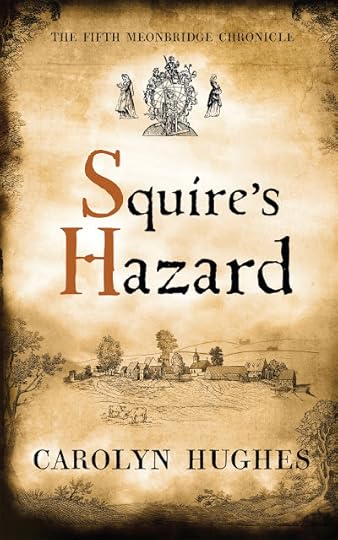
Guest PostFamily life in the fourteenth century
Family life is an essential aspect of the stories of all The Meonbridge Chronicles. Sometimes children’s lives are the, or at least a, focus of the book’s storyline and, of course, sometimes those storylines are sad, but by no means always.
It can’t be denied that having children was generally much riskier in the Middle Ages than in the twenty-first century.
Of course, it started with simply being pregnant. “Natural” it might be, but the difficulties that some pregnant women experience now were almost certainly untreatable in the fourteenth century, indeed unrecognised for what they were. And imagine being pregnant when you were labouring in the fields from dawn to dusk, then returning home to a cold and dark, and possibly damp one-room cottage. Of course, women across our modern world still labour when they’re pregnant, but I think a medieval peasant woman’s lot must have been very hard. The sheer fact of being pregnant and giving birth posed a huge risk for both mother and child. Losses, of both pregnancies and babies, were inevitably high.
For those babies who did survive their birthing in the middle of the fourteenth century, a dangerous world awaited them. It was a time when plague stalked the land; when bad weather (testing enough these days for some of us) often upset the natural cycle of food production and brought famine to many; when the new baby stood a fair chance of dying from disease or malnutrition before it could even walk; and when, once a child was on the move, the risks of injury or death from accident or ignorance were manifold. Of course, risks still attend our lives today but, in the Middle Ages, childhood was a time of considerable hazard, and the low life expectancy overall for people of the time is reflected in the high mortality rate of children.
The life of a child in the Middle Ages, especially perhaps a peasant child, was certainly very different from one now. They were expected to work from an early age, perhaps as young as five. Peasant children would accompany their parents into the fields and work alongside them. Maybe they didn’t do a great deal of actual work, but they carried out simple tasks and learned the jobs their parents did, doing more and more as they grew older. Middle class children – say, the sons and daughters of artisans – might have it slightly easier. They might possibly get a little education, and they might be sent away at a relatively young age to be apprenticed to a craftsman – girls as well as boys. Otherwise, they stayed at home and worked alongside their parents, probably acting as skivvies but also beginning to learn the craft.
Even upper class children’s lives weren’t necessarily easy. As with Dickon, the eponymous squire in Squire’s Hazard, a boy might be sent away at the tender age of seven to learn to be a page and then a squire in another household. A girl might be dispatched to another household too, to learn to be a “lady’ under the watchful eye of a woman who was not her mother. Then they might be married off when they were still quite young, maybe as young as twelve or fourteen. Lower class people did not marry so young.
Inevitably, loss and grief come often to Meonbridge parents. The first Chronicle, Fortune’s Wheel, opens with a young boy’s death, and the recent birth of that boy’s sister. The boy’s death was caused by an accident in his father’s mill, but it came soon after his parents had lost five other children to the plague – the Black Death, as we call it (1349-50). It’s hard to imagine the devastation such great loss would bring. Even the arrival of another baby might not be enough to stem their grief…
In Book 4, Children’s Fate, plague returns (as it did in 1361). It was called the Children’s Plague, because so many who died were young. It is not known exactly why, but we. might speculate that those who died didn’t have the protection that their parents might have gained after having survived the earlier plague. But of course medieval people didn’t know about such things.
There were other worries too: I have already mentioned accidents, which were commonplace for children. Sometimes quite young children were left in charge of their younger siblings. So far, so normal. But in houses where the only form of heating was an open fire, and the roof was made of straw, one doesn’t need an especially vivid imagination to envisage the potential dangers. Farm implements were probably left lying about, ponds and rivers wouldn’t have been fenced, wells were undoubtedly uncapped – there were all manner of possible hazards to tempt the wandering child.
Then, as now, too, there were threats from other people. In Children’s Fate, young girls, ostensibly apprentices, are exploited by their unscrupulous mistress. In A Woman’s Lot, young boys find them in trouble, intimidated into mischief by a teenaged ruffian. In De Bohun's Destiny, Dickon, still a child, is attacked by his grandfather’s enemies. In Squire’s Hazard, a teenager now himself, Dickon is under threat again, this time from a bullying fellow squire.
None of this is exclusive to the Middle Ages, of course, there have always been people who exploit the young.
But, despite their relative hardship and perhaps greater chance of mistreatment of one sort of another, I am certain that children had fun too. They played. They laughed. They teased each other. Though I presume they had few toys, especially the poorer children. I have it that one or two Meonbridge fathers carved wooden animals for their little ones. I also have children themselves being creative, such as the little girl who “fashioned a little ship from a curl of tree bark” to serve as an Ark for her wooden animals.
I have no doubt that, despite all the possible doom and gloom, and the hard life endured by most of Meonbridge’s working people, their children would have brought them joy, just as ours do today. I am certain too that children were as much loved and cherished then as they are now. Parents would have had to face loss more often than we do, but I don’t believe they felt the loss of a child any less keenly than modern parents would. Though they might believe the child – assuming it was baptised – had gone to a better world.
Of course, all these experiences, both good and bad, are timeless. They happen now too, the agonies and the joys. The big difference, perhaps, is that, in medieval times, the losses were attended by both lack of knowledge and understanding, and the greater risk of them occurring.
If you’d like to read a few excerpts from my novels of passages about children, why not read this blog post: https://carolynhughesauthor.com/2021/09/09/meonbridge-children-grief-and-joy/
Now, let's meet the author:
CAROLYN HUGHES has lived much of her life in Hampshire. With a first degree in Classics and English, she started working life as a computer programmer, then a very new profession. But it was technical authoring that later proved her vocation, as she wrote and edited material, some fascinating, some dull, for an array of different clients, including banks, an international hotel group and medical instruments manufacturers.

Having written creatively for most of her adult life, it was not until her children flew the nest several years ago that writing historical fiction took centre stage, alongside gaining a Master’s degree in Creative Writing from Portsmouth University and a PhD from the University of Southampton.
Squire’s Hazard is the fifth MEONBRIDGE CHRONICLE, and more stories about the folk of Meonbridge will follow.
You can connect with Carolyn through her website www.carolynhughesauthor.com and on social media.
You can follow Carolyn on these links:
Website - Twitter - Facebook - BookBub - Amazon Author Page - Goodreads
Keep up with the rest of the Squire's Hazard tour stops by clicking on the banner below:
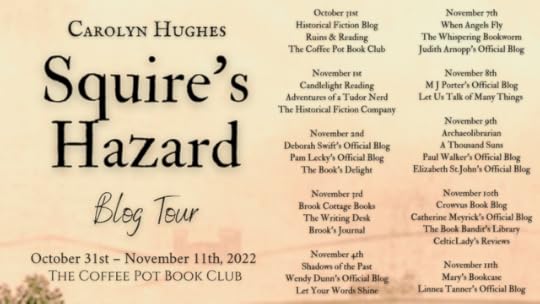
November 2, 2022
#HistFicThursdays - Skull's Vengeance - Linnea Tanner - Guest Post
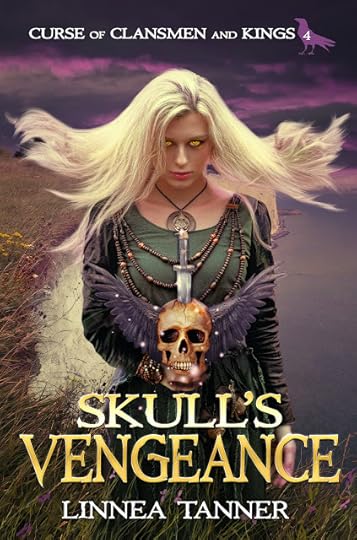
A Celtic warrior queen must do the impossible—defeat her sorcerer half-brother and claim the throne. But to do so, she must learn how to strike vengeance from her father’s skull.
AS FORETOLD BY HER FATHER in a vision, Catrin has become a battle-hardened warrior after her trials in the Roman legion and gladiatorial games. She must return to Britannia and pull the cursed dagger out of the serpent's stone to fulfill her destiny. Only then can she unleash the vengeance from the ancient druids to destroy her evil half-brother, the powerful sorcerer, King Marrock. Always two steps ahead and seemingly unstoppable, Marrock can summon destructive natural forces to crush any rival trying to stop him and has charged his deadliest assassin to bring back Catrin's head.
To have the slightest chance of beating Marrock, Catrin must forge alliances with former enemies, but she needs someone she can trust. Her only option is to seek military aid from Marcellus—her secret Roman husband. They rekindle their burning passion, but he is playing a deadly game in the political firestorm of the Julio-Claudian dynasty to support Catrin's cause. Ultimately, in order to defeat Marrock, Catrin must align herself with a dark druidess and learn how to summon forces from skulls to exact vengeance. But can she and Marcellus outmaneuver political enemies from Rome and Britannia in their quest to vanquish Marrock?
Trigger warnings:Sex, Slave trafficking and abuse, Violence, Childbirth
Skull's Vengeance is available on at your favourite bookshop via this universal link!
Acclaim for other books in the Curse of Clansmen and Kings series:"[An] epic tale of love, betrayal and political intrigue." ~ InD'tale Magazine"The requisite fantasy elements of magic and mystery abound...Tanner also does an admirable job weaving in the politics and mythology of a bygone people." ~ Kirkus"Part fantasy, part historical fiction, Linnea Tanner has woven together a wonderful tale of romance, intrigue, mystery, and legend to create an entertaining and complex story." ~ The International Review of Books"[A] captivating tale of triangles; love, lust and espionage; friend, foe, and spies; barbarians, civilized Rome and spiritual-supernatural beings." ~ 2019 Pencraft Book of the Year Award
Read the series: Apollo’s Raven (Book 1) - Dagger’s Destiny (Book 2) - Amulet’s Rapture (Book 3) - Skull's Vengeance (Book 4)
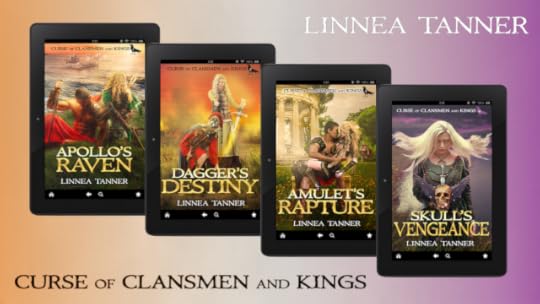
What are the pros and cons of writing a series of historical fiction rather than a stand-alone book?
Before I began writing the Curse of Clansmen and Kings series, I realized the epic tale had to be told in a series of books to cover the period between AD 24 – AD 40 in ancient Rome and Britannia. I now envision the series to consist of six books and a prequel. Other standalone novels using minor characters from the series have also come to mind.The pros of writing a series are that you can more fully develop characters, worldbuilding, and political intrigue. In a series, the tale comes across as epic and complex in scope. Several universal themes can be woven into the overall story arc.However, the reader’s interest in the characters and the story has to be maintained in order for them to continue reading subsequent books. It is sometimes difficult to have a satisfying ending for each book because it is an ongoing tale. Subsequent books in the series need to provide sufficient backstory to refresh a reader’s memory or to be read as a standalone book. Ideally, once the series is completed, the reader can read each book without having to wait for the next one to be published.
What was your favourite thing about writing from a mythological/fantastical stance?
The mythological/fantastical stance allows me to explore the culture and religious beliefs of ancient civilizations. I particularly enjoyed researching the Celtic fantastical aspects from Roman historical accounts and Welsh and Irish myths and legends. One of the Celtic beliefs that intrigued me was the concept that the soul resides in the head. The human head was venerated above all else since it was considered to be the temple of the soul. As with so many aspects of the Celtic warrior’s life, taking an opponent’s head in battle, preferably in single combat, had a mystical significance. To possess the enemy’s head was to possess his soul.The importance and extent of the cult of the severed head among the Celts is demonstrated by their display in shrines, either mounted in stonework at La Roquepertuse in southern Gaul or on wooden poles at the Bredon Hill Fort in western Britain. It is interesting to note that in both instances, the heads were set up at the entrances. Perhaps the souls of these unfortunate warriors protected their enemies’ strongholds. The Curse of Clansmen and Kings series expands on the concept that magical powers can be harnessed from souls trapped in each of their skulls.
 Pillars of the portico, with cavities designed for receiving skullsIII-II B.C. Musée d'archéologie méditerranéenne in Marseille.Image from Wikipedia
Pillars of the portico, with cavities designed for receiving skullsIII-II B.C. Musée d'archéologie méditerranéenne in Marseille.Image from WikipediaDo you think you would have survived in 1st Century Britain? What would be the best and the worst thing about living in the time of your books?
It would have been difficult to survive in 1st Century Britain with the political unrest between the rival tribal kingdoms and with the Romans. What I liked best about the Celtic culture in 1st Century Britain is that women were held in high regard and could own property and rule. The Roman historian Tacticus writes that the Britons were accustomed to women commanders in war. One of the worst aspects of 1st Century Britain was slave trafficking. To increase their wealth, tribal kingdoms often raided other territories to capture prisoners to sell into slavery. Slavery played a significant role in Roman society. Under Roman law, enslaved people had no personal rights and were regarded as property. They could be bought, sold, and mistreated at will. The tragedy of slave trafficking is woven into the storyline in Skull’s Vengeance.
Was there a single event/monument/artefact which inspired you to write about the Celtic world? If so, please tell us about it!
Whenever I visited London, I was intrigued with the statue of the ancient warrior queen, Boudicca, and her daughters in a horse-drawn chariot. The Roman historian Cassius Dio described her as being, “in appearance most terrifying, in the glance of her eye most fierce, and her voice was harsh: a great mass of the tawniest hair fell to her hips; around her neck was a large golden necklace.” She symbolizes how a single woman can unite divisive factions to rise up against tyranny and seek their freedom. My primary character, Catrin, is inspired by the legend of Boudicca and her Celtic world, which later inspired Arthurian legend.
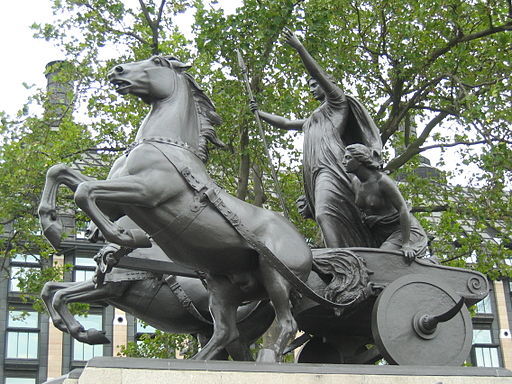 Boudicca StatueImage by Wikipedia Now, let's meet the author:
Boudicca StatueImage by Wikipedia Now, let's meet the author: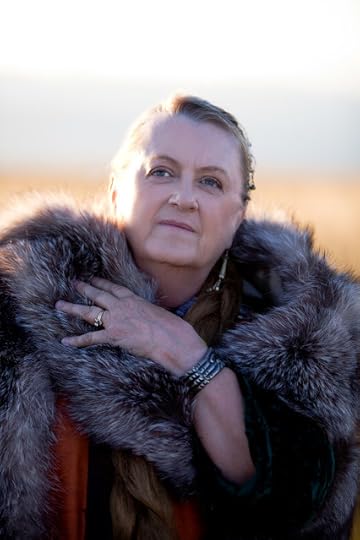 Award-winning author, Linnea Tanner, weaves Celtic tales of love, magical adventure, and political
Award-winning author, Linnea Tanner, weaves Celtic tales of love, magical adventure, and politicalintrigue in Ancient Rome and Britannia. Since childhood, she has passionately read about ancient civilizations and mythology. Of particular interest are the enigmatic Celts, who were reputed as fierce warriors and mystical Druids.
Linnea has extensively researched ancient and medieval history, mythology, and archaeology and has traveled to sites described within each of her books in the Curse of Clansmen and Kings series. Books released in her series include Apollo’s Raven (Book 1), Dagger’s Destiny (Book 2), and Amulet’s Rapture (Book 3). Skull’s Vengeance (Book 4).
A Colorado native, Linnea attended the University of Colorado and earned both her bachelor’s and master’s degrees in chemistry. She lives in Fort Collins with her husband and has two children and six grandchildren.
You can keep up with Linnea on these links:Website - Twitter - Facebook - LinkedIn - Instagram - Amazon Author Page - Goodreads - BookBub - Pinterest
Keep up with the rest of Skull's Vengeance tour stops by clicking on the banner below:
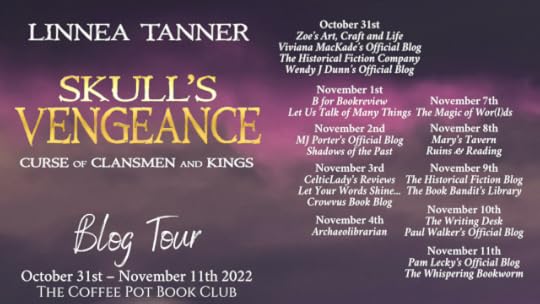
November 1, 2022
A Good Death: The Stubborn Dictator and The Headstrong King - Inspiration for "Vercingetorix's Virgin"
A Good Death: The Stubborn Dictator and The Headstrong King
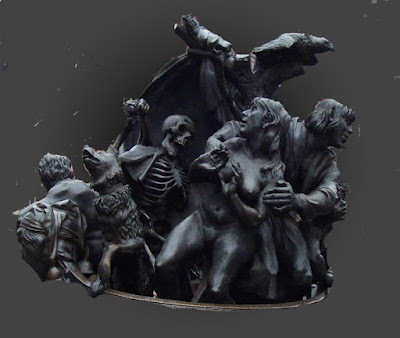 Memento Mori - Remember Death
Memento Mori - Remember Death(This is actually in Nuremberg,
but suited my purpose well!)
Death is an inevitability. There is nothing which levels the playing-field more than the acknowledgement that everyone must die. All of humanity, whether kings or serfs, will end their days in death.
Throughout history, across regions and religions, this has been a factor which has played upon the minds of mankind. Unsurprisingly, this has given rise to the notion of a "Good Death". The Vikings knew they could enter Valhalla if they died in battle, Christians knew they would be counted amongst the saints if they suffered martyrdom.
But if there is a good death, there must also be a bad death. A life taken in violent circumstances before its time, is believed by some to result in a restless spirit. There are a multitude of ghost stories about victims of murder, those with unfinished business, those who failed to achieve their earthly goals because their fellow man robbed them of the chance to do so.
Meet two such individuals:
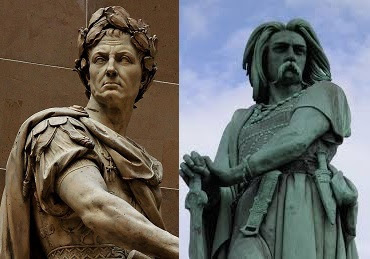 The Stubborn Dictator ~ The Headstrong King
The Stubborn Dictator ~ The Headstrong KingThe fact is, Julius Caesar and Vercingetorix had more in common than they would perhaps care to admit. And, while we remember far more about Caesar these days, if his life had been snuffed out at the same age as Vercingetorix, he may well have died at the feet of the statue of Alexander the Great, lamenting his own inadequacies. Vercingetorix, then, achieved more year for year than Caesar.
But such arguments are perhaps useless, because what people really remember of the two of them is the manner of their deaths. And they were both bad deaths. One was paraded as a trophy and then garrotted, the other was turned upon by his own people (and some historical conspiracies would have the ringleader as his own son) and stabbed to death before his peers. Like I said: bad deaths!
For the sake of Vercingetorix's Virgin, I wanted to change that. These men were giants of the ancient world, whether they spawned an imperial legacy or bloomed into a folk hero, both deserved to have a good death.
Vercingetorix was basically the anti-Caesar. Having a noble background, and revered as a king after leading his army to victory in Gergovia, this headstrong young man taunted the Romans at every opportunity - even needlessly risking his own army at times. But Caesar, perhaps older and wiser, perhaps only more stubborn, possessed far more patience. And patience was what won him the field at Alesia after a siege which had left the Gauls starved and weak.
They had both courted death at every opportunity. Always a good death, though. It wasn't fair that they died in the ways they did. So it was time to give them a second chance. Time to give them the opportunity to have their good deaths. I won't tell you what happens in the story, only that neither of them die in the manner they did in the original history.
As with all of us, their deaths were still inevitable, but now they could go on to achieve a good death. I gave them their chance to learn from one another. But you can never second-guess the response of that headstrong king or that stubborn dictator. They really did deserve each other, but they really didn't deserve to be remembered first and foremost for their bad deaths.
Read Vercingetorix's Virgin and seven other fantastic "What If?" stories in alternate endings !
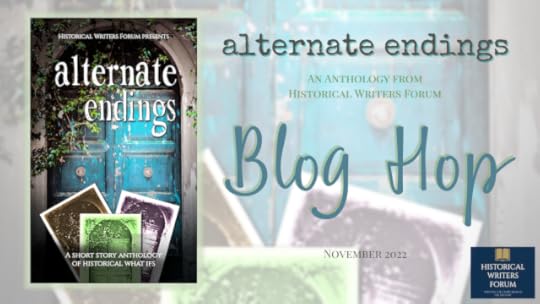
October 31, 2022
Introducing... Alternate Endings: A Short Story Anthology of Historical What Ifs
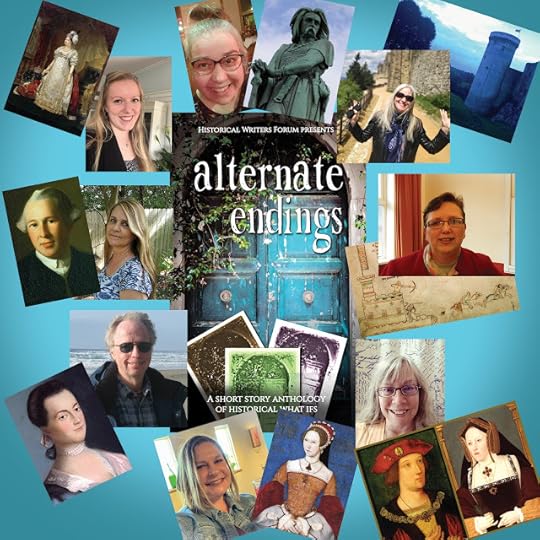
Yes, I know it isn't Thursday. But this is something which cannot wait!
It is my absolute pleasure to share this New Release with you! Eight members of the Historical Writers Forum were challenged to answer that niggling question all history-lovers ponder over:
What If?
All made very different choices, culminating in an eclectic mix of Alternate Endings. So, let's meet the book...
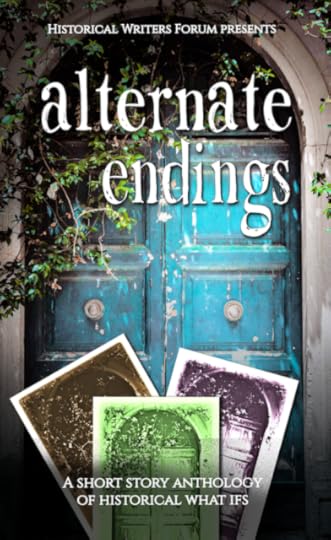
We all know the past is the past, but what if you could change history?
We asked eight historical authors to set aside the facts and rewrite the history they love. The results couldn’t be more tantalizing.
What if Julius Caesar never conquered Gaul?What if Arthur Tudor lived and his little brother never became King Henry VIII?What if Abigail Adams persuaded the Continental Congress in 1776 to give women the right to vote and to own property?Dive in to our collection of eight short stories as we explore the alternate endings of events set in ancient Rome, Britain, the United States, and France.
An anthology of the Historical Writers Forum.
Now, let's meet the authorsand their stories! (Listed in the order they appear in the book)
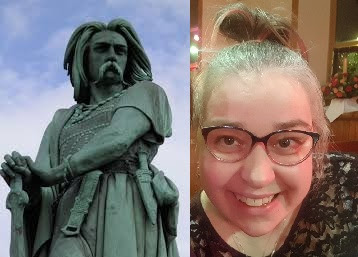 Virginia Crow - Vercingetorix's Virgin46BC - What if Julius Caesar never conquered Gaul..?
Virginia Crow - Vercingetorix's Virgin46BC - What if Julius Caesar never conquered Gaul..? Cathie Dunn - A Race Against Time1135 - What if Robert of Gloucester had not supported Empress Matilda..?
Cathie Dunn - A Race Against Time1135 - What if Robert of Gloucester had not supported Empress Matilda..?  Sharon Bennett Connolly - Long Live the King...1216 - What if King John didn't die in October 1216..?
Sharon Bennett Connolly - Long Live the King...1216 - What if King John didn't die in October 1216..?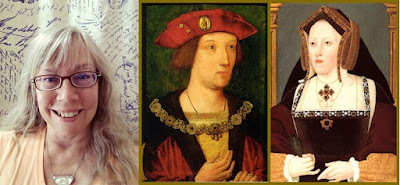 Karen Heenan - Princess of Spain
Karen Heenan - Princess of Spain 1519 - What if Arthur Tudor lived and his little brother never became King Henry VIII..?
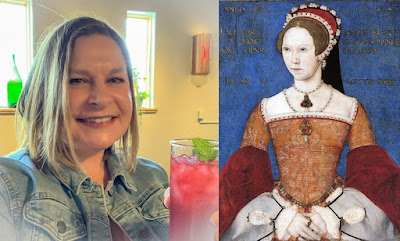 Samantha Wilcoxson - Tudors With a Twist1553 - What if Mary I married Reginald Pole..?
Samantha Wilcoxson - Tudors With a Twist1553 - What if Mary I married Reginald Pole..? Michael Ross - Remember the Ladies
Michael Ross - Remember the Ladies 1776 - What if Abigail Adams persuaded the Continental Congress in 1776 to give women the right to vote and to own property..?
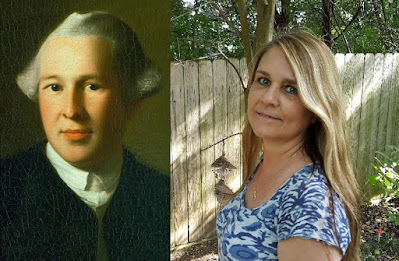 Salina Baker - Act Worthy of Yourselves1775 - What if Joseph Warren survived Bunker Hill..?
Salina Baker - Act Worthy of Yourselves1775 - What if Joseph Warren survived Bunker Hill..?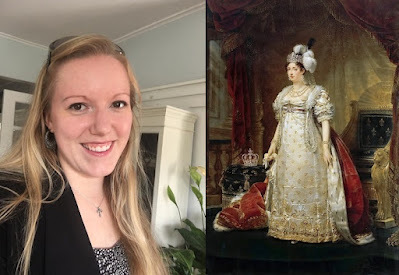 Elizabeth K. Corbett - Marie-Thérèse Remembers 1810 - What if France's royal family escaped the Revolutionaries?
Elizabeth K. Corbett - Marie-Thérèse Remembers 1810 - What if France's royal family escaped the Revolutionaries?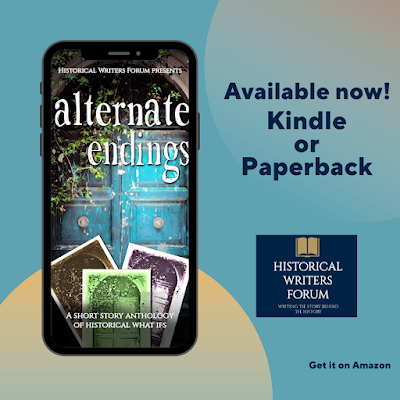 So, what are you waiting for? Click on this link:Alternate Endings on Amazonand find out what could have happened
So, what are you waiting for? Click on this link:Alternate Endings on Amazonand find out what could have happenedif these Alternate Endings had come to pass.
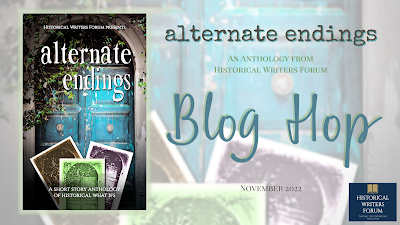 To keep up to date with the Alternate Endings Blog Hop,
To keep up to date with the Alternate Endings Blog Hop,follow the Facebook page here:Historical Writers Forum Blog Hop
Tempted into the realm of alternative history?
Comment below with what your What If? story would be.
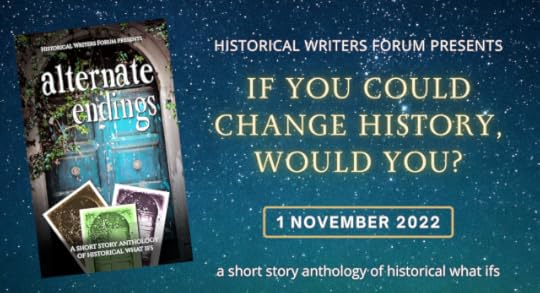
October 27, 2022
#HistFicThursdays - Horrible Histories 10 - Crassus: Minted
This week, I've been delving back into Ancient Rome, so this song was October's logical choice for a Horrible Histories blog. I'm so excited about the release of Alternate Endings, a collection of eight short stories from different historical writers. Each one (as the title suggests!) picked an event to change in history. Mine was the sparing of Vercingetorix's life.
So Julius Caesar has been at the forefront of my mind!
But Crassus was already dead by the time my story was set. In fact, his death triggered the collapse of that First Triumvirate. Unlike the later triumvirates, theirs was established solely to further their own ends individually. As the centuries turned, a certain hierarchy was established within each set of three, the geography reflecting this, but Caesar, Crassus, and Pompey were all as close to equal as they could be.
Despite the appearance in the video, however, they all equally disliked one another. There was a circle of mistrust amongst them and, although the triumvirate was formed to help them gain their own personal foothold with the senate, ultimately they sought to undermine one another's proposals. Caesar remained the quietest of the three in regard to this arguing, perhaps demonstrating the stubborn patience which would drive his campaigns over the next decade and a half. He married his daughter to Pompey and remained largely silent towards Crassus, who had acted as a guarantor for his debts.
Crassus knew the value of money, although he did not realise the limits such a value had. Unlike his fellow members of the triumvirate, the military was not second-nature to him and he believed buying his way into running an army was all which was required to lead men. Prior to the forming the triumvirate, he had the golden opportunity of the slaves' revolt, but a number of his men turned tail and fled from the battle. Determined not to lose face, Crassus resorted to decimation, randomly choosing one in ten of his remaining troops for execution. This act restored order and discipline, but it also served to unsettle his troops.
Perhaps unsurprisingly, his death was as a result of his failure as a military leader. Following the death of his son in a battle he was leading, and being forced by his men to recognise that his only way out was through negotiation with the Parthians, Crassus was on his way to an embarrassing submission. A misread action, when the Parthians believed Crassus was attempting to flee, resulted in his death, along with all the members of his party.
Money couldn't buy his way out of that!
The First Triumvirate collapsed. Animosity festered between Pompey and Caesar with no middle-man. Pompey was assassinated as he fled from Caesar, while Caesar went on to reach the position of dictator.
This song suits Crassus well: larger than life. When this one comes on in the car, the volume is turned up to maximum (minus one, because you should always keep one in reserve!) and the car rocks slightly as we reenact the dance as best you can while sitting down!
The moral of his story? Money can't buy you everything. But...
...It can buy you the opportunity to read my story, Vercingetorix's Virgin, along with those other seven fantastic what if? stories. Pre-order it here: Alternate Endings - and see what could have happened next!
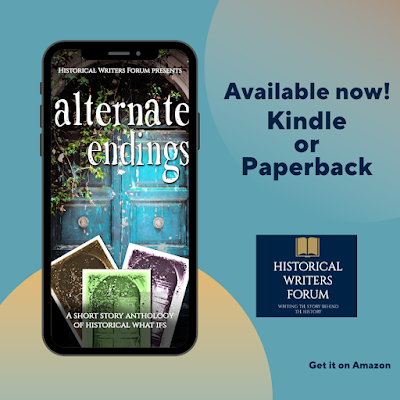
October 19, 2022
#HistFicThursdays - The Godmother's Secret - Elizabeth St.John - Guest Post

It's #HistFicThursdays, and I'm so thrilled to be sharing a guest post from Elizabeth St.John, as part of her Coffee Pot Book Club tour. Read on to find out about Elizabeth's love of the mystery surrounding the Princes in the Tower, and how she weaves this into her story. But first, let's meet the book..
Blurb
What if you knew what happened to the Princes in the Tower. Would you tell? Or would you forever keep the secret?
November, 1470: Westminster Abbey. Lady Elysabeth Scrope faces a perilous royal duty when ordered into sanctuary with Elizabeth Woodville–witness the birth of Edward IV’s Yorkist son. Margaret Beaufort, Elysabeth’s sister, is desperately seeking a pardon for her exiled son Henry Tudor. Strategically, she coerces Lancastrian Elysabeth to be appointed godmother to Prince Edward, embedding her in the heart of the Plantagenets and uniting them in a destiny of impossible choices and heartbreaking conflict.
Bound by blood and torn by honour, when the king dies and Elysabeth delivers her young godson into the Tower of London to prepare for his coronation, she is engulfed in political turmoil. Within months, the prince and his brother have disappeared, Richard III is declared king, and Margaret conspires with Henry Tudor to invade England and claim the throne. Desperate to protect her godson, Elysabeth battles the intrigue, betrayal and power of the last medieval court, defying her husband and her sister under her godmother’s sacred oath to keep Prince Edward safe.
Were the princes murdered by their uncle, Richard III? Was the rebel Duke of Buckingham to blame? Or did Margaret Beaufort mastermind their disappearance to usher in the Tudor dynasty? Of anyone at the royal court, Elysabeth has the most to lose–and the most to gain–by keeping secret the fate of the Princes in the Tower.
Inspired by England’s most enduring historical mystery, Elizabeth St.John, best-selling author of The Lydiard Chronicles, blends her own family history with known facts and centuries of speculation to create an intriguing alternative story illuminating the disappearance of the Princes in the Tower.
The Godmother's Secret is available on #KindleUnlimited via this Universal Link
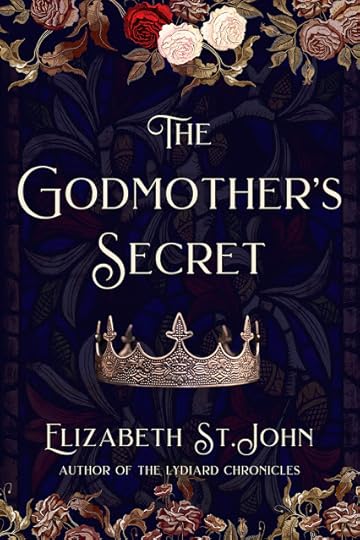
Guest PostIf you knew the fate of the Princes in the Tower, would you tell? Or forever keep the secret?
Thanks so much for having me on your blog. It’s fun to share my writing with your readers—and the research that goes on behind the scenes. As a little background, my books are inspired by my own family stories that I have discovered through our ancestral records, diaries, letters, and the locations they lived in. I’m fortunate the St.John family was prominent in English history, and so we left quite a trail—which can be both good and bad! My previous novels, The Lydiard Chronicles, are based on the diaries and records of my 17th century family, and it has been a glorious research journey uncovering their words and stories.
When I was looking for inspiration for my new book, The Godmother’s Secret, I literally entered my own name into our digitised family tree to see who else was recorded. I was so excited to find Elysabeth St.John who lived in the 15th century – and over the moon when I discovered she was the godmother to Edward V – the eldest brother of the missing Princes in the Tower. I had a new family story to investigate! And surely Elysabeth, above anyone else, would know what happened to those poor boys?
In medieval times, a godmother was considered a blood relative, and was responsible for the spiritual wellbeing and security of their godchild. A serious commitment! Where it gets interesting is that Elysabeth St.John was also the half-sister to Margaret Beaufort, mother of Henry VII. Elysabeth’s husband was a close ally of Richard III. So not only was Elysabeth (a Lancastrian) godmother to the York heir, she was also aunt to the Tudor claimant. Talk about family feuds!
My plot revolves around Elysabeth’s vow as godmother and her desperate efforts to protect her godson, Edward V, from the intrigue and betrayal that surrounds him after she delivers him to the Tower of London for his coronation. At the same time, she is dealing with her own conflict, upholding her loyalty to both her husband and her sister. More than anything, Elysabeth defies the bounds of blood and loyalty to make her own decisions for her godson’s survival in a hostile medieval world where women had little authority.

And remember, the princes went missing. Their bodies were never discovered, and no one was ever found guilty of murdering them. Even the bones that are claimed to be theirs in Westminster Abbey are not authenticated. Their disappearance is the biggest mystery in English history. As a historical fiction novelist, I could weave in genuine family facts and create my version of their story. About halfway through the first draft I came across a piece of research (basically a dynastic marriage) that made my story plausible, which was really exciting. As far as if my version is true? It’s historical fiction. We create narratives from the known facts, sift through rumours and gossip until we find the source – or can dismiss them.
I hope my readers enjoy the way I’ve presented the story of the Princes in the Tower. Of course, wading into the biggest controversy in English history is bound to raise some eyebrows. Did Richard III murder his nephews? Was Margaret Beaufort to blame? Or was the whole story Tudor propaganda? I am braced for some healthy debates! I’d love to hear from your readers their opinion of English history’s greatest mystery!
Now, let's meet the author:
 Elizabeth St.John spends her time between California, England, and the past. An acclaimed author, historian, and genealogist, she has tracked down family papers and residences from Lydiard Park and Nottingham Castle to Richmond Palace and the Tower of London to inspire her novels. Although the family sold a few country homes along the way (it's hard to keep a good castle going these days), Elizabeth's family still occupy them— in the form of portraits, memoirs, and gardens that carry their legacy. And the occasional ghost. But that's a different story.
Elizabeth St.John spends her time between California, England, and the past. An acclaimed author, historian, and genealogist, she has tracked down family papers and residences from Lydiard Park and Nottingham Castle to Richmond Palace and the Tower of London to inspire her novels. Although the family sold a few country homes along the way (it's hard to keep a good castle going these days), Elizabeth's family still occupy them— in the form of portraits, memoirs, and gardens that carry their legacy. And the occasional ghost. But that's a different story.Having spent a significant part of her life with her seventeenth-century family while writing The Lydiard Chronicles trilogy and Counterpoint series, Elizabeth St.John is now discovering new family stories with her fifteenth-century namesake Elysabeth St.John Scrope, and her half-sister, Margaret Beaufort.
You can follow Elizabeth on these links:
Website - Twitter - Facebook - LinkedIn - Instagram - BookBub - Amazon Author Page - Goodreads
Keep up with the rest of the The Godmother's Secret tour stops by clicking on the banner below:
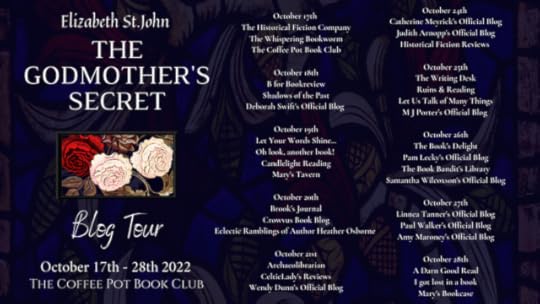
October 12, 2022
#HistFicThursdays - When History and Fiction Dance - Guest Post - Tempest Wright
Happy #HistFicThursdays! Today, I'm thrilled to be sharing a guest post from Tempest Wright's work in progress: The McKarthy Journals: Brothers In Secrets! Read on to share in the guest post - and what an incredible title for a post it is! - but first, let's meet the book...
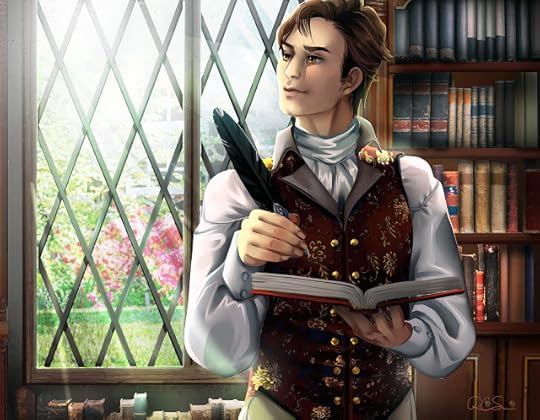 Brendan - one half of the McKarthy pair...Blurb
Brendan - one half of the McKarthy pair...Blurb
In 1822, there is no way for one to dissolve an arranged marriage or aspire to higher fates…unless one is fortunate enough to possess an acquaintance with the McKarthy brothers. While veiling themselves in a shroud of propriety, the brothers wield their position within high society to defy social norms for the liberation of many – at the expense of a few.
The sudden appearance of a notorious London criminal in their quiet corner of Kent, not only threatens everything achieved through the Mckarthys’ indiscretions, but conjures up a dark history the brothers are desperate to keep buried. Juggling to maintain their façade and contain this impending threat, the brothers soon begin to realize the murderous presence is no coincidence, but the onset of something – or someone – far more dangerous...
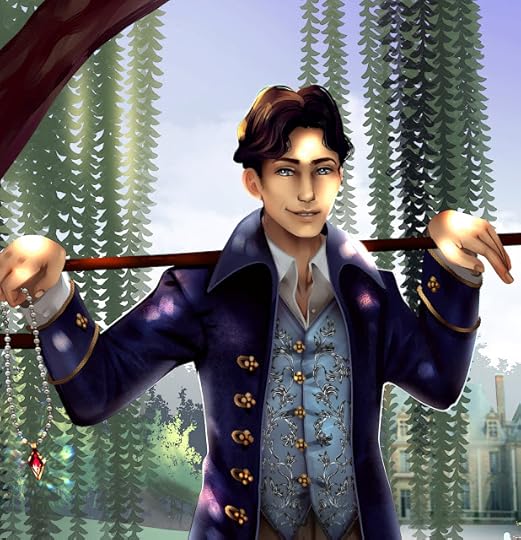 ...And Matthew - the other half!
...And Matthew - the other half!Guest PostWhen History and Fiction Dance
Their eyes lock, prompting him to take his first step forward.
Weaving through the crowd, he never once glances away; her beauty a mesmerizing lure.
She glances down nervously, sure she must be mistaken. But once before her, his steady gaze gives no excuse for mistaking. History offers Fiction his hand.
“Shall we dance?”
Their fingers touch, the curious spark igniting into a blazing fire. Enraptured, they dance about the floor in a seamless waltz.
Ah, the magic of writing historical fiction! Some authors make it look easy.
For many historical fiction authors, history is indeed the leading man. He is the one that inspires them. Fiction follows his lead, bringing long-dead history back to life.
But what if the roles were reversed? Can Fiction be the leading man?
This can be a particularly dangerous situation.
Too often, Fiction as the lead tries to step on the toes of History, dragging her where he wants to go, instead of elegantly leading her across the dancefloor. We’ve seen this so often in movies and books where pieces of integral history are tossed away or forgotten in favor of a good story.
True, Fiction by nature, is rather manipulative. When cast as the lead of inspiration, can he be anything less than a villain?
Here is my confession: fiction has always taken the lead in my life. It doesn’t take much for my imagination to run amuck with characters and intricate plots.
I’m going to terrify a few, I’m sure, when I admit most of my inspiration came through movies; not historical fact or even reading. Watching A&E’S version of Pride and Prejudice excited my imagination towards the regency; Rupert Everette’s take on Oscar Wilde’s Lord Goring made me fall in love with wit and satire, and Anthony Andrews was the most perfect Scarlet Pimpernel one could ask for – a man just as at home in lace and silk as he was in mud and rags in front of a French guillotine. Thankfully, these inspirations did get me reading the source material.
But it also fostered a love of older settings. I love going to historical theme parks and buildings and being emersed in history, by brain promptly making up stories of the fictional people who lived there.
From these inspirations, The McKarthy Brothers were born.
However, as often is the case when Fiction takes the lead, I began to realize that my story did not automatically sync with history. I had simply thrown my characters into the 1820’s, thinking it would be a good decade. Alas, Napoleon, abolition and the war of 1812 happened before this, and the Victorian era, with its massive change and reforms, was about ten years ahead. I wanted my brothers to play an integral role to change…and found I hadn’t exactly thought this through.
Thus, my leading man Fiction went scanning the dancefloor to find Lady History for validation. To my absolute horror, he offered his hand to a lady of political history (I rather detest politics). But from this treacherous waltz, I found The Great Reform Act of 1832.
I’m sure, for many readers here, this is just a part of your national history. Perhaps you were taught in school. But as a Canadian, this great Reform Act that paved the way for multiple reforms in the 19th century, hadn’t really been stressed in history class.
What piqued my interest was the eradication of many Rotten Boroughs.
Rotten Boroughs were a corrupt form of political representation. Boroughs were election districts, having the ability to send one or two MPs to the House of Commons. Voters were required to own property that had a rateable value of forty shillings a year. But the boundaries of these boroughs, while they could be expanded and moved, did not take into account the number of voters they had. Many boroughs that once held thriving cities in the Middle Ages, were now nothing more than tiny hamlets.
The most infamous Rotten Borough, Old Serum, held only three houses, and claimed seven voters, but sent two MP’s to Parliament. Manchester housed over sixty thousand people at the time, but was given no representation.
The lack of voters allowed the wealthy patrons who owned the borough, (often themselves in the House of Lords) to easily wield their wealth and power, convincing the voters to send the MPs that would suit their own interests. This gave them even more control in the government, and less to the constituents the MP’s were supposed to represent.
Leading men of Fiction would be tempted to skip over details, and leave this political history where they found her. But here lays the key to writing with Fiction taking the lead: be patient.
A good fiction lead will learn more for the sake of making their story as realistic as possible. Shall we see how this might play out?
“Fascinating,” he says, “but may I ask a theoretical question?”
Her eyes narrowed, as he guided Lady History through a turn. “I detest theoretical questions,” she answered.
“Pray oblige me, for your knowledge is vast,” he begged, then diverted her in a new direction. “If a conniving patron wished to gain more power, would it not be a matter of holding these rotten boroughs.”
“Perhaps,” she says coyly, “however history shows there were many such patrons. One man would surely attract attention by claiming them all.”
“True,” Fiction sighs, his eyes searching for another option. “What about a conniving Lord who wishes to ingratiate himself to such patrons. If he exercised influence over them, would he not influence their MP’s and even England by extension?”
“Theoretically, but he’d have to be very conniving,” she answered as he pulled her in from a twirl. Her keen eyes glared back at him. “What are you thinking?”
In truth, he is thinking of how this historical Reform Act would act as a climax in ending his fictional antagonist’s aims; a fictional character ruined from very real circumstance.
No, if your Fiction is a smart leading man, he will not tread upon the toes of history. He will tease her, and flirt precariously with truth – but not bully her into submission. In fact, he should entertain every hope of dancing with her again, for there are many things to glean from Lady History.
In the case of the 1832 Reform Act, what made Arthur Wellesley, the Duke of Wellington, acquiesce to the bill the third time it was before the House of Lords? What made those MP’s who benefitted from this arrangement, pass it? What made Lord Earl Grey fight for it so?
If Fiction is to make his fictional characters and events stand out just as strongly against historical players and events, he must dance with History over and over again.
As anyone might have guessed, the first book of my McKarthy Journals series, Brothers In Secrets, is largely fiction, emersed in a historical era. But as the series progresses, they manipulate historical characters and events under history’s radar, all the while allowing history to retain its truth.
Truth be told, I’ve always felt that History and Fiction are both inherently flawed.
History, while full of events, people, and details of truth, has bias, exaggerations, and gaps. Fiction takes these details and gaps, and fills them with exaggerations and theoretical possibilities of its own.
The one thing in both their favor is that they are innately human.
They both convey human emotion and ambition: one delivering the outcome and consequences of these things through time; and the other using them to fill in whatever history cannot speak. Both speak to the human heart and mind.
Whether you are a historian dabbling in fiction, or a fiction-lover dabbling in history, both will only be valid if you can make history and fiction dance seamlessly as one. So for all the historical authors out there, have fun for whichever is your strongest passion, take to the floor and enjoy the dance!
You can follow Tempest on these links:
Facebook - Instagram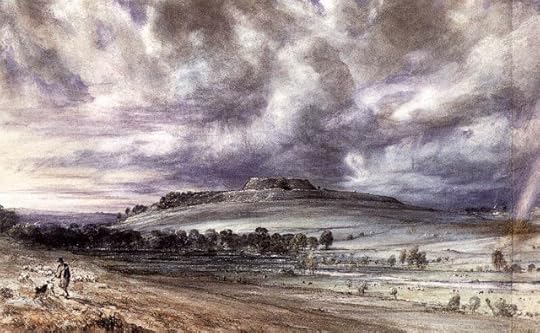 One of Tempest's inspirations:
One of Tempest's inspirations:Constable's Old Sarum
(accessed via Wikimedia)
October 6, 2022
#HistFicThursdays - Brushstrokes from the Past - Heidi Eljarbo - Guest Post
 It's #HistFicThursdays, and I'm so excited to be sharing a guest post from Heidi Eljarbo, as part of her Coffee Pot Book Club tour. Find out all about Heidi's connection with art and her thoughts on the most important piece of art in history. But first, let's meet the book..
It's #HistFicThursdays, and I'm so excited to be sharing a guest post from Heidi Eljarbo, as part of her Coffee Pot Book Club tour. Find out all about Heidi's connection with art and her thoughts on the most important piece of art in history. But first, let's meet the book..Blurb
A Historical Art Mystery
WWII and the mid-seventeenth century are entwined in this fourth dual timeline novel about Nazi art theft, bravery, friendship, and romance.
April 1945. Art historian Soli Hansen and her friend Heddy arrive at an excavation site only to find Soli’s old archeology professor deeply engrossed in an extraordinary find in a marsh. The remains of a man have lain undisturbed for three centuries, but there’s more to this discovery…
As Soli tries to understand who the baroque man was and discovers what he carried in a sealed wooden tube, problems arise. A leak reveals the finds to the notorious Lieutenant Colonel Heinz Walter, and soon, both Nazi elite and the Gestapo are after the treasure.When Heddy and the professor disappear along with the artwork, Soli and her resistance group must find them before it’s too late.
1641. In Amsterdam, French musketeer Claude Beaulieu has had his portrait done by his close friend and artist Rembrandt van Rijn. When a band of thieves steal the precious painting, Claude and his wife Annarosa Ruber pick up their swords and a few belongings and go after the culprits.
Set in Norway during the tumultuous last days of the second world war, as well as the peak of the glorious baroque art period, these two stories are a must for readers who love historical fiction with adventure, suspense, and true love that conquers all.
Perfect for fans of Kate Morton, Lucinda Riley, Kathleen McGurl, Rhys Bowen, and Katherine Neville.
Brushstrokes from the Past is available on #KindleUnlimited via this Universal Link

Guest PostThe most important work of art in history
When our four children were young, we lived in Austria for five years. One summer we drove to Paris to take the children to Disneyland, the Eiffel Tower, Versailles, and Louvre. Our youngest, then six years old, was super excited to see the famous Mona Lisa. When we approached the iconic portrait inside one of the most famous art galleries in the world, she took one look at the small, framed painting and said, “I’ve seen it. Now we can go home.”
Ranking the most important work of art in history is a difficult, if not impossible, task. I believe many have been surprised at how small Leonardo da Vinci’s most celebrated portrait is. Compared to, let’s say, The Coronation of Napoleon by Jacques-Louis David which is almost 10 meters (33 ft) wide by a little over 6 meters (20 ft) tall, the three-quarter pose of Mona Lisa measures only 77 cm × 53 cm (30 in × 21 in). But the crowd at the Louvre is evidence of how popular it is.
Another painting—actually a huge fresco—by Leonardo da Vinci is The Last Supper and was made even more well-known through Dan Brown’s mysterious thriller and later movie, The Da Vinci Code.
Many have come to know certain artwork through books or movies. Some examples are Girl with a Pearl Earring by Dutch baroque artist Johannes Vermeer. Many other artworks have also inspired both authors and moviemakers.
One of my favorite paintings is a fifteenth-century piece by Jan van Eyck's called the The Arnolfini Portrait or Arnolfini’s Wedding. I have been to The National Gallery in London several times and beheld this portrait which is filled with symbolism. Like Mona Lisa, it’s surprisingly small, but I never get tired of studying it.
On the list of most famous paintings are also newer pieces like The Scream by Edvard Munch, Guernicaby Pablo Picasso, and The Kiss by Gustav Klimt. But what makes a painting famous or beloved? Is it how much a collector is willing to pay for it at an auction? The beauty of it? The details, hues, and exquisite brushstrokes? Or because most people simply like it?
There’s an air of mystery to the most well-known pieces. Who is the woman named Mona Lisa and why does she smile?
I enjoy studying famous painters who ventured into new styles and new art techniques. As an example, Botticelli was commissioned by a member of the wealthy Medici family to paint what is known as The Birth of Venus. The Medicis had ruled Florence and nearby areas for centuries and enjoyed quality art. Botticelli’s amazing rendition of the goddess of love was painted around 1485, and with this the artist dared to be different. He painted on canvas instead of wood and the newborn goddess Venus is completely naked, only covered up by her long hair and her hand. Shocking? It probably was at that time.
So, as a common thread in the four books of the Soli Hansen Mysteries, I chose to start with the father of chiaroscuro, Caravaggio. The Italian painter was an artist who dared to be different and develop his own painting techniques. At a time when commissions from the Catholic Church and other prominent members of society were vital to baroque artists, Caravaggio took a chance. He painted shoeless people with dirty feet. He wanted to portray pauperism and the rawness of human existence. He communicated through his paintings an important Christian message that faith and worship are for all mankind, the poor and the rich. In the beginning, the Church outrightly rejected his renditions. Saints and angels were not to be depicted like paupers with dirty feet. But with time, even the Augustinians—the influential fraternity in Rome—were touched by the sincerity of truth and modesty in Caravaggio’s paintings.
In my dual timeline novels Of Darkness and Light, The Other Cipher, Hidden Masterpiece, and the newest book, Brushstrokes from the Past, the entwined second story starts with a young woman who has her portrait painted by Caravaggio. In the following books, the story continues with two other master painters who were greatly influenced by Caravaggio’s chiaroscuro technique of light and dark. We follow Rubens and Rembrandt as they continue and further develop this technique.
What do I think is the most important work of art in history? I believe every person could make their own top ten list. Maybe some would choose Vincent van Gogh’s The Starry Night from 1889 as their favorite. I have a weakness for Italian and Dutch baroque art, but also eighteenth-century art of the United Kingdom.
It’s all individual. It depends on what a certain painting makes you feel. Choose what you love.
Now, let's meet the author:

Heidi Eljarbo is the bestselling author of historical fiction and mysteries filled with courageous and good characters that are easy to love and others you don't want to go near.
Heidi grew up in a home filled with books and artwork and she never truly imagined she would do anything other than write and paint. She studied art, languages, and history, all of which have come in handy when working as an author, magazine journalist, and painter.
After living in Canada, six US states, Japan, Switzerland, and Austria, Heidi now calls Norway home. She and her husband have a total of nine children, thirteen grandchildren—so far—in addition to a bouncy Wheaten Terrier.
Their favorite retreat is a mountain cabin, where they hike in the summertime and ski the vast, white terrain during winter.
Heidi’s favorites are family, God’s beautiful nature, and the word whimsical.
Sign up for her newsletter at https://www.heidieljarbo.com/newsletter
You can follow Heidi on these links:
Website - Twitter - Facebook - LinkedIn - Pinterest - Instagram - BookBub - Amazon Author Page - Goodreads
Keep up with the rest of the Brushstrokes from the Past tour stops by clicking on the banner below:

September 29, 2022
#HistFicThursdays - Horrible Histories 9 - The Plague Song
As a child, there was no book scarier than the Weetabix history book's page about The Black Death. Forget horror or ghosts, plague was really scary! It took me a long time to realise that "plague" did not refer to a single event, too. One of the things which led me to this was trying to make sense of the much-loved book The Children of Green Knowe, in which the ghostly children died in the plague three-hundred years after I knew The Black Death had occurred.
I don't know at which point I became fascinated with the history of medicine but, around that time, I stopped being so scared of the plague. When, years later, I began writing Day's Dying Glory, one of the key characters just had to be a doctor. Doctor Fotherby became central to what grew into a family saga. Reluctant to let him go, he had a very long life before I conceded that I just could feasibly have him lasting much longer!
But Doctor Fotherby belonged to the 18th/19th Centuries, long after this song is set. Our image of plague doctors, with the long beak-like masks, came from the 17th Century. Incidentally, I have to mention here a fabulous graphic novel, The Plague and Doctor Caim by G.E. Gallas, which is a well-researched and accessible book, as well as being stunningly illustrated! But even this is not far enough back to reach this song...
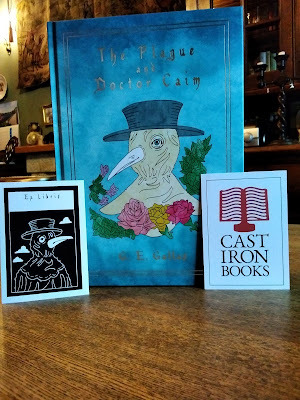
While we were on holiday in Highland Perthshire a few years ago, we drove through Kirkmichael village. I'd heard of it before from a post someone had put up on Twitter about the plague burial ground within the kirkyard. I was intrigued. When my sister, a teacher at our local primary school, asked me to write a story set in the Middle Ages for her class, this was the perfect story.
A quick listen-through of the song tells you that the doctors in the middle ages didn't really have much of an idea about how to deal with the plague! And not only the doctors, but priests too. This was the case in Kirkmichael, with the Bishop of Dunkeld announcing that only sinners who refused to drink the consecrated water died of the plague. Sadly, this was not true. It was at the bishop's warning that the plague pit in Kirkmichael was established and remains untouched to this day.

Writing a doctor at this time was an interesting challenge and, true to the time and the spirit of children's literature, Moonlight Finn was not a doctor as we would recognise them today, but an alchemist. Delving into the teachings of the humours was incredible. It was fascinating how these early beliefs and procedures were so close to succeeding without knowing how or why. While this approach to medicine - largely unaltered from that of the Greeks - was primitive, it had its own strange logic based on genuine research and effectiveness. Moonlight Finn is no different... But no spoilers here! I hope to get it published at some point, and at least I have the reassurance that the children for whom it was written enjoyed it. And, because it's by me, it naturally has a twist!

The plague is like an extra character in the book: a foreboding, mindless evil wielded as a weapon by some, while others attempt to defend against it. Each plague in history, and Covid too in modern day culture, lends itself to this. There's a very different sort of plague in my upcoming book The Strength of Caledon, but this follows the same rules.
Because this was one of my earliest fears within books, it's perhaps no surprise that, in all my historical stories, the real heroes are doctors, in their different guises.
Crowvus Book Blog
- Virginia Crow's profile
- 128 followers


